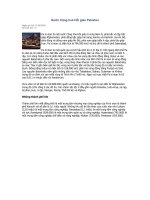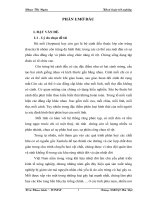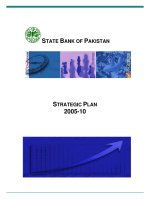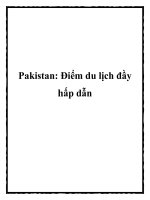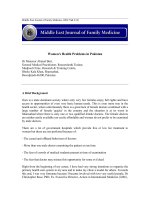Decentralization pakistan
Bạn đang xem bản rút gọn của tài liệu. Xem và tải ngay bản đầy đủ của tài liệu tại đây (439.68 KB, 39 trang )
Pakistan's Decentralization:
Implications and Challenges for
Delivering Water and Sanitation
Services
Raja Rehan Arshad
Water and Sanitation
Program for South Asia
1
Big Bang Decentralization
Local Government Ordinance promulgated on
August 14, 2001
Devolution of political and fiscal authority to
elected Local Governments
Decentralization of administrative authority
Water and Sanitation
2
Pre-Devolution Context
Four Provinces
Districts
Sind
Balochistan
North-West Frontier Province
Punjab
Sub-divisions for deconcentrated arms of the provincial
government administration and technical line
departments
W&S service delivery being a provincial
responsibility
Water and Sanitation
3
Major Impediments
Overlap of jurisdictional assignment
More than one technical department responsible
for W&S
Public Health Engineering Department, and Local
Government and Rural Development Department in rural
areas
W&S authorities and/or municipalities in urban areas
Centrally planned system of service delivery
Absence of accountability between the
providers and the client
Water and Sanitation
4
Major Impediments (Cont…)
Lack of capacity and appropriate institutional
framework for sectoral planning; preparation
of financially viable sector investments; and
management of demand responsive
investments
Absence of strategic vision – in particular the
implications of urban and rural transformation
for the W&S sector.
Water and Sanitation
5
W&S Service Delivery Situation
W&S systems investments without
consideration of O&M arrangements
Centrally financed, operated and managed
In the last decade, move towards community
ownership, and operation and maintenance, but old
systems still a major liability
Both in rural and urban, public sector water utilities
heavily subsidized by the government
In rural areas, cost recovery less than 10 percent
In urban areas, cost recovery between 10 to 40
percent
Water and Sanitation
6
Local Government Ordinance (LGO)
2001
Creation of approximately 100 district
governments and district councils (average
population of a district is one million)
Creation of approximately 350 tehsil municipal
administrations and tehsil councils (average
population of a tehsil is 500,000)
Creation of approximately 7,500 union
administrations and union councils
(population ranges from 18,000 to 28,000)
Water and Sanitation
7
LGO 2001 (Cont …)
Direct elections have been held only at the
Union level
The Deputy Mayor of the Union Council is a
member of the Tehsil Council
The Mayor of the Union Council is a member
of the District Council
All the union councilors in a tehsil and district
elect the Deputy Mayor and Mayor for the
respective tehsil and district
The Mayor and Deputy Mayor have to contest on
a Joint Ticket (one vote for both)
Water and Sanitation
8
Salient Features of the LGO 2K1
Complete fiscal authority to each level
However during transition, the province is maintaining some
decision making with regards to appointment of staff, setting of
tariffs and tax structures, etc.
Rural – Urban divide has been removed
Mega cities (million plus) have become City Districts and
the remaining districts are referred to as Common
Districts comprising urban and rural areas
District, Tehsil, and Union are not subordinate to one
another
Principle of Subdiarity is the main theme
Tax base for each level
Water and Sanitation
9
Salient Features (Cont …)
The new law has:
Decentralized service delivery providers and
assets (approximately 30 provincial departments
ranging from social services such as health and
education to agriculture and soil conservation)
Removed jurisdictional and functional overlap of
institutions
Water and Sanitation
10
Salient Features (Cont …)
Introduced a new system of transparency and
accountability
Empowered local governments to enter into a
range of institutional arrangements – from
community owned systems to contracting out and
contracting in of services
In order to ensure flexibility district
governments can transfer functions to the
lower levels
Water and Sanitation
11
Salient Features (Cont …)
The lower levels can assume functions
provided they finance them themselves and
get appropriate clearances
To strengthen participation two institutions
have been created:
Village/Neighbourhood Councils, which will be
elected
Citizen Community Boards, which will have to be
registered with the district government
Water and Sanitation
12
Different Tiers
COMMON DISTRICT
ZILA COUNCILDISTRICT
GOVERNMENT
TEHSIL COUNCILTEHSIL MUNIPAL
ADMINISTRATION
UNION COUNCILUNION
ADMINISTRATION
VILLAGE
COUNCIL/NEIGHBOUR
HOOD COUNCIL
CITY DISTRICT
ZILA COUNCIL-CITY
DISTRICT
GOVERNMENT
TOWN COUNCIL-TOWN
MUNICIPAL
ADMINISTRATION
UNION COUNCILUNION
ADMINISTRATION
VILLAGE
COUNCIL/NEIGHBOUR
HOOD COUNCIL
Water and Sanitation
13
Key Outcomes
Rationalization of agencies responsible for
service delivery
For W&S, PHED, LGRDD, Physical Planning and
Housing and Urban Local Councils have been
merged at the Tehsil level
Removal of the rural-urban divide – creating
space to achieving financial and management
efficiencies through the creation of regional
municipal management units, i.e., the Tehsil
Municipal Administration
Water and Sanitation
14
Key Outcomes (Cont …)
Introduction of efficiencies through
encouragement of institutional and
organizational robustness, in particular the
introduction of:
Subsidiarity
Co-Production
Public-Private Partnership
Regional management of services including
regional utilities, management of multi-village
W&S systems, etc.
Water and Sanitation
15
Key Outcomes (Cont …)
Focusing on direct lines of accountability with
a focus on information transparency and
localized decision making
Participation of citizens in decision making
and service delivery through the Citizen
Community Boards (CCB’s), through which
25 % of the development budget has to be
spent
Water and Sanitation
16
Key Outcomes (Cont …)
Provincial Finance Commissions have been
established for intergovernmental transfers
Criteria includes:
Population
Poverty
Backwardness
Resources
Incentive (Punjab only)
Water and Sanitation
17
Extension of Local Government
Village Councils/Neighbourhood Coucils
An elected body representing the interests of a
particular village or neighbourhood
Citizen Community Boards (CCB’s)
Non-profit organizations or stakeholder
associations working on development related and
social welfare activities
Water and Sanitation
18
Tehsil Municipal Administration
(TMA)
Responsible for Municipal Services in rural
and urban areas
Other levels of local government have no
responsibility and/or role for municipal services
except in City Districts, where the District (Metro)
level is responsible for macro municipal services
mainly (bulk water supply, etc.). Distribution and
solid waste is still the responsibility of TMA and/or
Union Administration
Average population of a tehsil is 500,000
Water and Sanitation
19
TMA (Cont …)
TMA has the flexibility to balance
decentralized service delivery against
economies of scale
Can have multi-village management
Single village management
TMA is responsible for three key components
of municipal management:
Sectoral planning
Capital works
O&M
Water and Sanitation
20
TEHSIL MUNICIPAL ADMINISTRATION
ORGANIZATION
Tehsil Council Secretariat
TEHSIL MUNICIPAL OFFICER
General Estab./Admin.
Audit
CO at
TMA HQ
CO at nonTMA HQ
CO at nonTMA HQ
CO at
non-TMA
HQ
CO at nonTMA HQ
CO at nonTMA HQ
Planning and
Coordination
•Spatial (Physical
Planning)
•Land Use Planning
(Land sub-division,
zoning, land use)
•Development
Facilitation/Control
•Building
Facilitation/Control
•Housing, Site
Development, Katchi
Abadi Amelioration
Plans
•Coordination and
liaison with neighbouring
tehsils and unions/VC
O&M Centres Working Under Chief Officer
Infrastructure and
Services
•Water Supply,
Sewerage/Drainage
•Sanitation
(Solid Waste)
•Roads, Streets and
Street Lighting
•Fire Fighting
•Parks and Open
Spaces
•Traffic Engineering
Regulation
•Facilities, Markets
and Enterprises
•Licenses
•Regularisation of
Tenure of Katchi
Abadis
•Land including Rights
of Way, Drains
(Temporary tehbazari and
encroachments)
Finance
•Accounts
•Budget
−Annual
−3 year rolling
−Cost accounting
•Revenue
−Vigilance
(Detection and prevention
of revenue leakages and
losses)
−Survey
(Revenue base – current
and potential)
Nature of the TMA
Body Corporate
Consist of a Tehsil Nazim, Tehsil Municipal
Officer, Tehsil Officers, Chief Officers from the
offices entrusted to the TMA
No distinction between a rural and an urban
area in the law
Can further transfer responsibility to the lower
tiers along with transfer of resources
Entire Tehsil space is a Rated Area for
Property Tax purpose
Water and Sanitation
22
Nature of the TMA (Cont …)
Can contract out and contract in
services
Upper tiers can transfer responsibility to
the tehsil along with transfer of
resources
TMA continues to be responsible for
regulating and monitoring service delivery
Cannot borrow from the capital market
However, upper levels can extend advances
or give loans
Water and Sanitation
23
Functions of the TMA
The TMA is exclusively responsible, in the
Common District, for planning, capital
investments and operation and
maintenance of:
Spatial Planning (land use and zoning)
Development Facilitation and Control (site
development and building control)
Municipal Services (water, sanitation, solid
waste, roads, streets, street lights, graveyards,
fire fighting, traffic engineering, abattoirs,
parks and open spaces)
Water and Sanitation
24
Composition
All present Town Committees, Municipal
Committees and Municipal Corporations
Provincial Government Departments
which will be decentralised to the TMA:
Local Govt. and Rural Development
Department
Public Health Engineering Department
Housing and Physical Planning (apart from
the nucleus for the District)
Water and Sanitation
25

